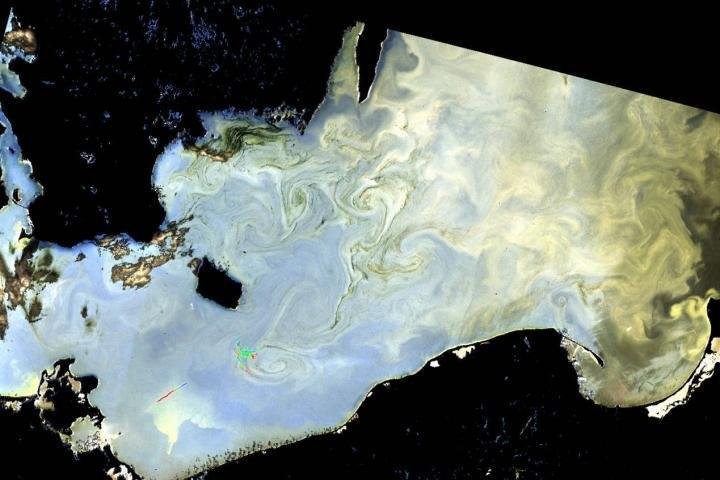Researchers say that rising seafood demand and coastal development may be linked to an increase in more harmful algal blooms, such as the one pictured in the Baltic Sea. Photo by European Space Agency
June 8 (UPI) -- New analysis of thousands of harmful algae blooms, or HABs, has revealed links between increases in the damage caused by algae blooms and human activities, including aquaculture development.
The international study, organized and funded by UNESCO's Intergovernmental Oceanographic Commission, featured several dozen scientists from all over the world. Scientists analyzed the timing and extent of more than 9,500 HABs over the last 33 years.
The analysis -- published Tuesday in the journal Communications and Earth and Environment -- revealed strong links between algae blooms and increased stress on marine resources, undermining the notion that global warming and rising ocean temperatures are the primary driver of harmful algae blooms.
"There has been a widely-stated contention that HABs worldwide are increasing in distribution, frequency or intensity, so a quantitative global assessment is long overdue," lead author Gustaaf M. Hallegraeff, a professor at the University of Tasmania's Institute for Marine and Antarctic Studies, said in a press release.
By amassing data on thousands of HABs, researchers were able to establish a baseline with which to compare future changes in the frequency, origins and extent of harmful algae blooms.
Records from a pair of databases, the Harmful Algae Event Database and the Biodiversity Information System, showed HABs are increasing in the Caribbean, South America, Mediterranean and North Asia.
Harmful algae blooms are occurring slightly less frequently, however, along the West Coast of the United States and along the coasts of Australia and New Zealand.
Almost half of all the analyzed HABs yielded seafood toxins, while approximately 7 percent resulted in mass plant and animals deaths.
Researchers had to work hard to standardize the HAB records from different parts of the world. HAB monitoring efforts are more robust, for example, in places where aquaculture development has dramatically increased.
Even when accounting for this, researchers found strong links between aquaculture development and harmful algae events.
While scientists suspect increases in nutrient pollution from aquaculture activity can help explain increases in HAB events, they suggest more analysis is necessary to confirm the link.
Given that algal blooms serve as a direct threat to both human health and the health of marine ecosystems, it's imperative that scientists work out the connections between aquaculture and HABs.
"Overexploitation acts as a natural multiplier of the effects of HABs, leading to an increase in impacts independent of an actual trend in HABs," said co-author Adriana Zingone, researcher at Stazione Zoologica Anton Dohrn in Italy.
Unlike previous studies, which have suggested HABs are increasing exponentially in all parts of the world, the latest findings suggest more nuanced trends.
Still, the scientists suggest it is imperative that marine researchers and policy makers improve their ability to forecast the threats posed by HABs.
"As the human population continues to increase in tandem with resource demands, HABs will predictably constitute a serious threat in terms of seafood safety and security, a hindrance to recreational uses of the sea, and a problem for the tourism industry," said study co-author Henrik Oksfeldt Enevoldsen.
"Occurrences of harmful species over time and their human impacts can be expected to change locally, regionally and globally alongside the effects that climate, hydrography and human pressure impose on the coastal environment," said Enevoldsen, a researcher at the University of Copenhagen.















